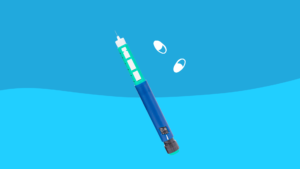Tresiba Vs Ozempic – Understanding the Differences and Effects
HOME | DIABETES EDUCATION | TRESIBA VS OZEMPIC – UNDERSTANDING THE DIFFERENCES AND EFFECTS
Diabetes management hinges on choosing medications like Tresiba and Ozempic for glycemic control. Understanding their mechanisms and effects is crucial. Each medication has unique dosages, efficacy, and long-term benefits.
Differentiating how Tresiba and Ozempic impact glucose levels can optimize treatment strategies for better outcomes and improved quality of life for those managing diabetes.
Key Takeaways
- Tresiba and Ozempic offer distinct mechanisms to improve glycemic control with specific benefits in lowering HbA1c levels and inducing weight loss.
- Tresiba allows for flexible dosing tailored to individual needs, while Ozempic provides a convenient weekly dosing option.
- Both medications share common side effects like gastrointestinal disturbances and the risk of hypoglycemia if not managed properly.
- Consulting healthcare providers aids in selecting the optimal medication based on injection frequency, side effects, effectiveness, and individual preferences.
Tresiba Vs Ozempic: Mechanism of Action
Tresiba – long-acting basal insulin, provides consistent release over 42 hours.
Ozempic – GLP-1 receptor agonist, stimulates insulin secretion, suppresses glucagon.
Tresiba – insulin degludec, stabilizes insulin levels, aids glycemic control.
Ozempic – enhances insulin secretion, reduces glucagon, improves glycemic control.
Ozempic – offers cardiovascular benefits, supports weight loss in type 2 diabetes patients.
Distinct mechanisms of Tresiba and Ozempic aid in diabetes management for personalized treatment and optimal outcomes.
Glycemic Control: Tresiba Dosage
The optimal dosing strategy for Tresiba in achieving glycemic control involves an initial dosage typically starting at 0.2 units/kg or 10 units once daily, with adjustments tailored to individual requirements.
Tresiba should be administered subcutaneously once daily at any consistent time. Dosing adjustments must be made cautiously to prevent hypoglycemia or hyperglycemia, with the maximum recommended dose being 50 units per day.
The flexibility of Tresiba dosing allows for individualized treatment plans to address the unique needs of patients with diabetes, ensuring optimal glycemic control. By starting at a conservative dose and titrating based on response, healthcare providers can help patients achieve and maintain their glycemic targets while minimizing the risk of adverse events.
It is essential for healthcare professionals to closely monitor patients when making dosage adjustments to ensure the best outcomes in glycemic control.
Ozempic Effects on Glucose Levels
Clinical trials have shown that Ozempic, a GLP-1 receptor agonist, effectively lowers blood sugar levels in individuals with type 2 diabetes. Ozempic reduces HbA1c levels by about 1.5% to 1.8% when used alone. Patients using Ozempic experience weight loss due to decreased appetite and slowed gastric emptying. The medication’s glucose-lowering effects are sustained over time, leading to improved glycemic control. Ozempic also provides cardiovascular benefits, making it a valuable treatment option for type 2 diabetes patients.
| Aspect | Effects |
|---|---|
| HbA1c Reduction | Approximately 1.5% to 1.8% decrease |
| Weight Loss | Due to decreased appetite and slowed gastric emptying |
| Cardiovascular Benefits | Demonstrated alongside glucose-lowering effects |
Comparing Tresiba and Ozempic Efficacy
Tresiba and Ozempic both improve glycemic control and reduce cardiovascular risks in type 2 diabetes patients. Tresiba, a long-acting insulin, lowers HbA1c levels for stable control. Ozempic, a GLP-1 receptor agonist, reduces HbA1c levels and body weight effectively. Both medications decrease cardiovascular event risks.
Choosing between Tresiba and Ozempic depends on individual patient needs and responses for optimized outcomes.
Common Side Effects of Ozempic and Tresiba
Common side effects associated with Ozempic and Tresiba include gastrointestinal disturbances and injection site reactions, respectively.
Ozempic may lead to symptoms such as nausea, vomiting, diarrhea, and abdominal pain, while Tresiba often causes injection site reactions like redness, itching, or swelling.
Both medications carry the risk of hypoglycemia if not appropriately managed.
Additionally, Ozempic’s side effects may extend to decreased appetite and weight loss, whereas Tresiba might trigger allergic reactions such as itching, rash, or breathing difficulties in certain individuals.
Tresiba Vs Ozempic: Onset of Action
Tresiba, with insulin degludec, peaks within 9 hours post-administration, showing a faster onset of action than Ozempic, containing semaglutide, which may take weeks to reach its full effect.
Tresiba’s quick onset leads to immediate glycemic control, while Ozempic requires a longer time for its therapeutic effect to be realized.
Understanding these differences is essential for optimizing blood sugar management.
Adjusting Tresiba and Ozempic Dosing
Adjusting Tresiba and Ozempic dosing is crucial for optimizing glycemic control in individuals with diabetes. Tresiba dosing requires titration based on individual needs to achieve optimal control. Factors such as current insulin regimen, blood glucose levels, and lifestyle influence Tresiba dosing adjustments.
Ozempic dosing typically follows a weekly titration schedule to reach the maintenance dose for improved control. Dosing adjustments for Ozempic are guided by treatment response to achieve target HbA1c levels.
It is essential to carry out dosing adjustments for both Tresiba and Ozempic under healthcare provider guidance for safe and effective management. Monitoring and adjusting dosing according to individual needs and treatment goals help individuals better manage blood glucose levels and work towards target HbA1c levels.
Tresiba Vs Ozempic: Hypoglycemia Risk
When considering the management of hypoglycemia risk associated with Tresiba and Ozempic, it is crucial to understand their mechanisms of action and impact on glycemic control.
Key Points:
Tresiba:
Insulin therapy nature may lead to hypoglycemia.
Risk influenced by dosing, timing, and individual characteristics.
Ozempic:
Lower hypoglycemia risk as a GLP-1 receptor agonist.
Stimulates insulin production based on blood sugar levels.
Switching from Tresiba to Ozempic:
- Potentially reduces hypoglycemic events.
- Different mechanisms of action contribute to this outcome.
Understanding risk factors, dosing considerations, timing, and mechanisms of action of Tresiba and Ozempic is essential in managing hypoglycemia in patients. Tailoring treatment based on these factors helps optimize glycemic control while minimizing hypoglycemia risk.
Long-Term Glycemic Control With Tresiba
Tresiba contributes to sustained glycemic control in patients with diabetes by providing consistent basal insulin coverage. This helps stabilize blood glucose levels, reducing variability and improving glycemic control over time.
Insulin degludec is well tolerated in patients with DM. It improves glycemic control with reduced HbA1c, FPG, and postprandial glucose, with a low risk of hypoglycemia.
Studies show lower rates of hypoglycemia with Tresiba compared to other long-acting insulins, enhancing its safety profile. Tresiba’s ultra-long duration of action allows for flexible dosing schedules, aiding adherence and minimizing missed doses.
Patients report enhanced glycemic control and reduced blood sugar fluctuations with Tresiba, highlighting its efficacy in promoting long-term stability in diabetes management.
Ozempic Benefits for Type 2 Diabetes
Ozempic, a once-weekly injectable GLP-1 receptor agonist used for type 2 diabetes, provides significant benefits:
HbA1c level reduction: Ozempic lowers HbA1c levels, improving long-term glycemic control.
Weight loss: It helps patients with type 2 diabetes lose weight.
Cardiovascular protection: Ozempic reduces the risk of major adverse cardiovascular events in diabetic patients.
Side effects: Commonly reported side effects include gastrointestinal symptoms like nausea and vomiting.
Convenient dosing: Its once-weekly schedule may enhance treatment adherence and simplify diabetes management.
Drug Interactions When Using Ozempic or Tresiba
When using Ozempic or Tresiba with other medications, monitor for potential drug interactions that may affect glycemic control. Ozempic, containing semaglutide, can delay gastric emptying, impacting the absorption of oral medications.
Tresiba, with insulin degludec, may interact with oral medications affecting blood glucose levels, possibly requiring dosage adjustments. Both medications can interact with drugs lowering blood sugar, increasing the risk of hypoglycemia.
Combining Tresiba with certain medications like beta-blockers may mask typical symptoms of hypoglycemia. Disclose all medications, including over-the-counter drugs and supplements, to healthcare providers when using Ozempic or Tresiba to manage potential drug interactions that could compromise glycemic control.
Vigilance and proactive communication are crucial for optimal treatment outcomes.
Patient Preference: Tresiba or Ozempic
When choosing between Tresiba and Ozempic, patients consider factors like injection frequency, side effects, and effectiveness. Tresiba needs daily dosing, while Ozempic is taken weekly. Side effect profiles and overall effectiveness differ between the two.
Tresiba is a long-acting insulin, while Ozempic is a GLP-1 receptor agonist. Ease of use also plays a role in decision-making. Consulting healthcare providers can help patients make the best choice based on their preferences and medical needs.
Frequently Asked Questions
What Is the Glycaemic Control?
Glycemic control is the careful management of blood glucose levels to prevent diabetes complications. It involves monitoring A1C, FBG, and PPG levels. Achieving optimal control depends on medication adherence, lifestyle choices, and regular monitoring.
What Is Good Glycemic Control?
Maintaining good glycemic control involves keeping HbA1c levels below 7% and fasting blood glucose between 80-130 mg/dL. This requires adherence to medication, lifestyle changes, and regular monitoring for effective diabetes management.
How Do You Maintain Glycemic Control?
Consistent blood glucose monitoring, prescribed medication adherence, regular physical activity, balanced diet, stress management, and sufficient sleep are key for maintaining glycemic control. Engagement with healthcare providers for monitoring and treatment adjustments is vital for effective management.
How Can I Increase My Glycemic Control?
Focus on regular exercise, a balanced diet, blood sugar monitoring, medication adherence, and stress management to enhance glycemic control. Tailoring treatment plans, tracking progress, and collaborating with healthcare providers are essential for optimizing glycemic control.



